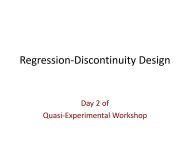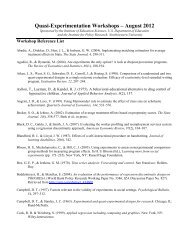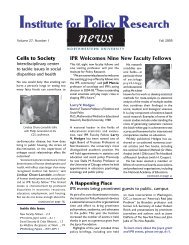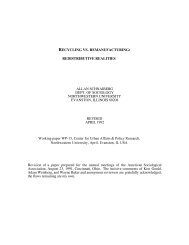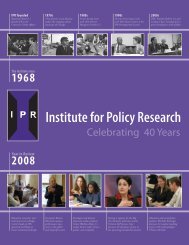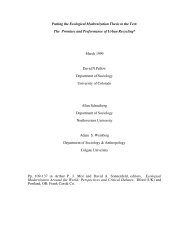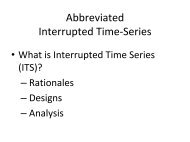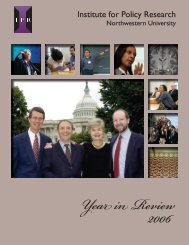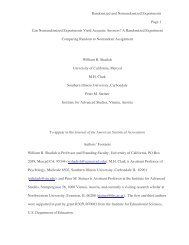Download working paper PDF - Institute for Policy Research ...
Download working paper PDF - Institute for Policy Research ...
Download working paper PDF - Institute for Policy Research ...
Create successful ePaper yourself
Turn your PDF publications into a flip-book with our unique Google optimized e-Paper software.
post-re<strong>for</strong>m. This complicates our regression analysis, since the results we observe in any<br />
given post-re<strong>for</strong>m year reflect a mix of pre- and post-re<strong>for</strong>m claims. Stated differently, the<br />
2003 re<strong>for</strong>ms either apply or don’t apply to any given claim, but the effects of tort re<strong>for</strong>m<br />
phase in over time when viewed across all closed claims.<br />
A. Overview<br />
III. Empirical Results<br />
We begin with an overview of the “bottom line” of total med mal payouts. Figure<br />
1 shows total payouts <strong>for</strong> elderly and non-elderly claimants, both pre- and post-re<strong>for</strong>m.<br />
The solid line shows total payouts to non-elderly plaintiffs; the dotted solid line shows<br />
total payouts to elderly plaintiffs (multiplied by four <strong>for</strong> visual presentation), and the rising<br />
dashed line shows the ratio of the two. As Figure 1 reflects, payouts to adult non-elderly<br />
claimants were roughly flat from 1990-2003, but crashed after tort re<strong>for</strong>m was enacted,<br />
from an average of about $160 million over 2001-2003 to only $48 million in 2007. 25<br />
Payouts to elderly claimants increased steadily from under $10 million during 1988-1990<br />
to around $40 million over 2001-2003, be<strong>for</strong>e dropping to $14 million in 2007. The share<br />
of total payouts received by elderly claimants increased from an average of less than 5%<br />
over 1988-1990 to around 15% over 2000-2003, with no clear post-re<strong>for</strong>m time trend. As<br />
Figure 1 shows, tort re<strong>for</strong>m has thus far had a similar impact on elderly and non-elderly<br />
claimants, despite suggestions of a greater effect on the elderly in the popular and<br />
academic literature (including our own simulation study). We explore below the extent to<br />
which the post-re<strong>for</strong>m trends we observe are attributable to changes in claim frequency,<br />
payouts per claim, or both.<br />
injury was prior to the effective date of the re<strong>for</strong>ms, but no lawsuit was filed, so we cannot conclusively<br />
determine whether the 2003 tort re<strong>for</strong>ms apply.<br />
25 Figure 1 includes 1988-1989. Under-reporting of claims during those years means that total payouts<br />
(the top two lines in the figure) will be low. We include these years in the figure because we have no reason<br />
<strong>for</strong> thinking that the under-reporting affects the ratio of payouts to elderly v. non-elderly claimants (the<br />
bottom line in the figure).<br />
6



